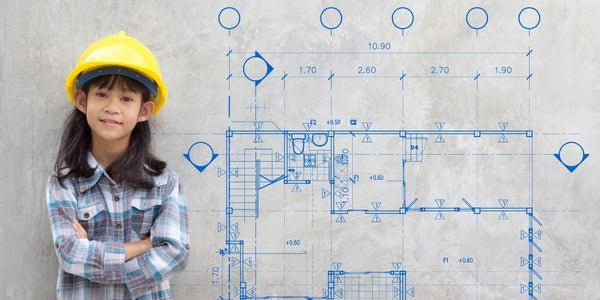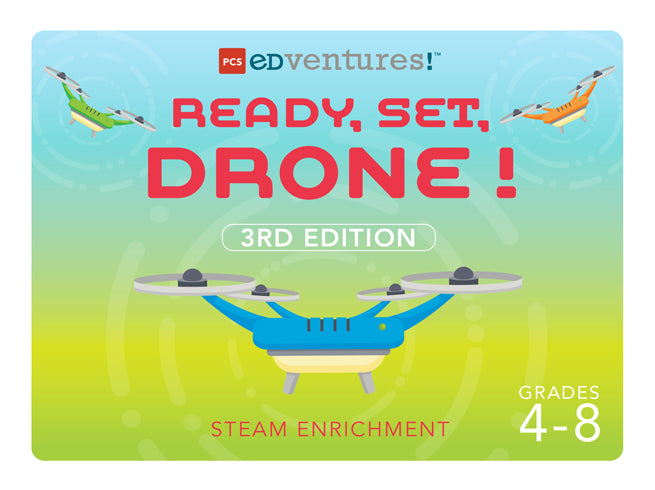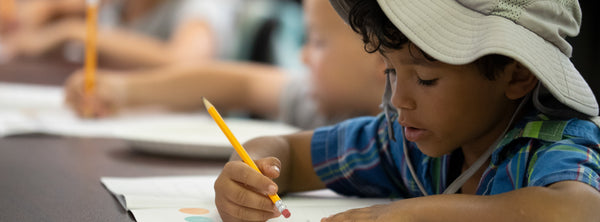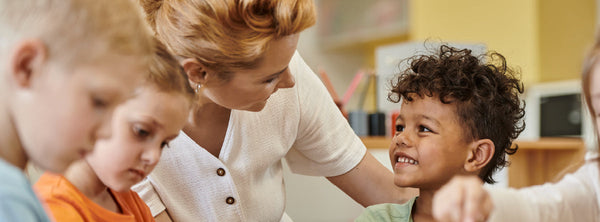
Integrating the Engineering Design Process in STEM Spaces
For any great design, there is a great plan. From Leonardo da Vinci to Thomas Edison to Steve Jobs, the inventors and innovators who created the world we live in each began as a person with an idea. An idea turned into a plan and the plan turned into a prototype and the prototype turned into a product.
That process, moving from an idea to a finished product, is known as the engineering design process and isn’t only for famous inventors. This technique can be used by anyone and is a great way for students to learn STEM principles. Let’s take a look at what the engineering design process is made of, then see how you might integrate it into your teaching.
What is the Engineering Design Process?
The engineering design process, also known as iterative design, is a cycle that provides a framework for addressing the world’s problems with inventive, effective solutions. From researching the issues society faces and the complications surrounding them to fine-tuning designs by tinkering with variables, the engineering design process puts STEM in students’ hands, teaching them to think like an inventor in all areas of life.
The engineering design process stands in stark contrast to the two traditional approaches students can take to new problems. At one extreme, there is “guess and check.” In the “guess and check” model, students invest little to no energy in planning their approach to a problem. Rather, they simply try something and then adjust, repeating this process until they either stumble upon a solution or lose interest in the problem. This is not always bad. When the stakes are low, there is no harm in this. However, when materials and time are limited, “guess and check” is not an efficient approach.
The second, sometimes problematic, approach to problem-solving (the one historically emphasized in any technical academic program) is purely analytical, wherein the first attempt is expected to be perfect, flawless if possible. I like to call this approach the “one and done.” While this method certainly has academic and educational merit, it fails to take into consideration practical, application-level issues (imperfect parts, environmental variation, etc.). This “one and done” approach can also put undue pressure on learners to rely on detailed instructions rather than fostering a creative engineering mindset.
Sidenote: Scientific inquiry is a related but separate process that refers to the use of questioning, testing and analysis to answer questions. While the scientific method is a process used to test ideas and construct explanations, the engineering design process is a method of solving problems and generating solutions to human wants and needs.
How do you make it?
So let’s whip up a batch of engineering design — we’ll start with the essential ingredients, then take a look at the step-by-step instructions for a perfect final project.
The 6 Essential Ingredients
- Curiosity - Before you can build the next iPhone, you need the inspiration of curiosity. Curiosity is an internal drive encouraging you to question things — to not accept everything just because “that’s the way it is.” Without curiosity, you won’t be able to identify potential solutions to the world’s problems, which means you won’t be able to solve them.
- Critical Thinking - Critical thinking is the foundation for successful engineering. In order to build something well, you need to think critically about problems in the world, complications surrounding them and the people impacted. And that’s all before you start considering possible solutions! It doesn’t stop there — once you have an idea, you’ll need to think about which materials could make a good solution, what design the solution should have and what features would best serve the people it is meant to help.
- Technical Knowledge - It’s always going to take a dash of technical knowledge to engineer something new. Whether you need to know machinery, adhesives or electronics, you’ll want to study up or partner with an expert in that area. This will help you manufacture something safely and efficiently without too many false starts.
- Creativity - Creativity is the secret sauce of the engineering design process — it’s unique to each person and gives the whole thing flavor. Many people perceive engineering as a black and white field, but engineers need a lot of creative ideas in order to make something new or improve something that has been done the same way forever. A good engineer thinks about the problem from different angles and attempts to consider perspectives from consumers, manufacturers and any other stakeholders involved.
- Global Perspective - A healthy dose of global perspective is not only a starting point for identifying problems to solve; it also helps you make something useful to the stakeholders involved with the problem you’re trying to solve. An appreciation for people, culture and the environment will help you make products with multiplying positive effects for everyone affected.
- Passion - Passion is key to endurance through obstacles (which are bound to come up at some point) and the fuel for innovation. Without passion, an inventor will lose interest in the project and never see it through to the end.
The Engineering Design Process Steps:
The engineering design process is a cycle...

- ASK: Before you get out the tools, there are a few important questions to ponder. First of all, what is your goal? What are you trying to accomplish? What problem are you trying to solve? Once you’ve answered these questions, dig into the details that will affect how you approach the problem: What are the criteria and constraints surrounding that problem? Who will your invention help?
- IMAGINE & EXPLORE: The next step helps you develop ideas through brainstorming and research. In this phase, no idea is a bad idea. Get the creative juices flowing and try to come up with a bunch of possible solutions. Think about the following questions: What are different ways of solving the problem? What is the most basic solution? What features could you add for more robust results? What variables go into the solution that you could change?
- DESIGN: In this step, you will narrow down the list of possibilities you came up with during your brainstorming session. Decide on a single solution and develop a plan for testing it. Just like real-world engineers, you can only develop a limited number of models based on available time and materials, so pick an idea you believe will work, not something totally outlandish. Draw a labeled blueprint for your design and make sure that everyone who will be a part of the construction process is on the same track — that way you will have a model that works cohesively when it comes time to put it all together.
- MAKE A PROTOTYPE: It’s finally time to break out the tool box! Create a model that you will use to test your design. Try not to make any modifications to your plan at this point. Work with the model you’ve created and make notes if there are elements you want to consider modifying in future iterations.
- TEST: Once you’ve got a working prototype, test your model and systematically gather feedback. Depending on what type of problem you are solving, this process will look different. You might be testing how far a machine can fly or how much a device can collect or how fast a vehicle can go — whatever your goal is, make sure to record measurements and units accurately and make notes on your method. In future tests, you’ll want to replicate this process as precisely as possible so you can compare iterations. With your first prototype, try picking one variable to change. Compare the results from the original model (or control group) and the new version (test group).
- EVALUATE: Once you have all of your data, it’s time to get into the numbers. Analyze your results. Does your model solve the problem as well as you thought it would? When you changed a variable, did the prototype function better, the same, or worse? What external factors might have affected your model’s performance?
- REFLECT: Before redesigning the model and starting the process again, reflect on the results of your test. What worked well that you’d like to keep? What didn’t work as expected and could be improved? Now that you’ve done it once, are there any new possible solutions you would like to try out? Is there an area of the project that is missing expertise?
Once you’ve answered these questions, it’s time to go back to the design phase, creating a new prototype that will be better than your first. Repeat this cycle until you have reached your desired goal or have developed a product that meets the need you are trying to fill.
Engineering in Action
What does the engineering design process look like in action? While iterative design can be found throughout our products, we’re going to focus on one example.
In Ready, Set, Drone!, an aviation program for learners in grades 4-8, students build launch and landing pads for their mini drones out of BrickLAB bricks. Each learner takes on the role of an engineer, faced with the challenge to build a platform on which they can land their drone during flight practice. Following the steps of the engineering design process, students begin by asking questions and establishing the framework for their landing pad builds. These questions might include: “How much space will it take to land the drone? What sizes of bricks do we have to work with? What kind of surface will the launch pad stand on?”
Once all student questions are answered, each team dreams up possible solutions, decides on one model and sketches the design in their science notebooks, labeling the landing pad parts and the brick sizes they will use. Teams then get their bricks and start building!

With the landing pads built, it’s time to test the designs. Students don their safety glasses and grab the drone controls. Their goal: lift off from their brick landing pad and land back on it. As they fly, students record data in a flight log in their science notebooks, writing down the date, flight number, flight duration and any notes about their performance.
Once each student has made an attempt at a successful flight, everyone comes back to debrief, evaluating their level of success. Questions to pose at this time include: “How well did each group meet the engineering criteria? Were groups able to lift off and land the drone back on their launchpads? Would anyone want to redesign their launchpad with the experience they have now? What would you change?”
In order to make note of their reflections, students create a plus/delta chart, writing a list of things that went well and things they would like to change. Everyone shares what they’ve learned before coming back for a redesign. By repeating the process of engineering design, students learn how to optimize their landing pads and get a framework for creating future inventions of their choice.
Ready to integrate the engineering design process in your learning environment? Start here.
Discover Engineering
- Grades: 4-8
- Subjects: Engineering, Math, Physics, English Language Arts
- In Discover Engineering, cultivate the young engineers of tomorrow. Geared to bolster student literacy with rapidly evolving technology, this kit fosters student confidence, critical-thinking and other important 21st-century skills while getting learners excited about STEM.
Ready, Set, Drone!
- Grades: 4-8
- Subjects: Technology, Engineering, Physical Science, English Language Arts
- Take to the skies with mini drones! Paired with thrilling, easy-to-operate aerial robotics equipment, this program is the perfect introduction to the world of unmanned aerial vehicles (UAVs). Safety is a priority as students learn to fly and capture aerial photos and videos, exploring real-world applications and possibilities of drones while developing their own science and engineering practices.
To bring engineering to life check out Discover: The World of Robotics, Physics and Engineering Webinar where our experienced hosts lead you on a deep dive into all things robotics, engineering, physics and more!

For custom STEAM solutions, contact a STEM Program Specialist at (800) 429-3110 or sales@edventures.com










